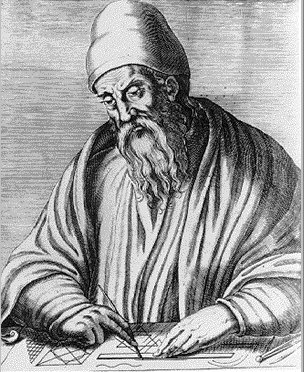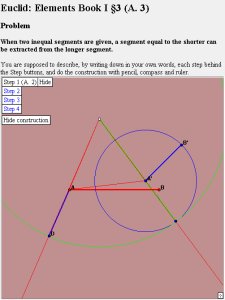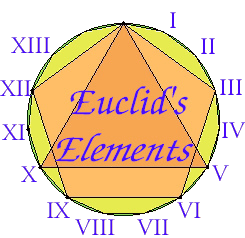GEOMETRY: A Supplementary problem sheet for Euclid's Elements
Book I
The following JSP-applet constructions show
in several steps the geometrical problems in Euclid's Elements, book I
Euclid: Elements Book I §1 (A. 1)
Proposition 1
Draw an equilateral triangle whose sides are equal to a given segment.
1. Constructions
Describe, by writing down in your own words,
each step behind the Step buttons, and do the constructions with pencil, compass and ruler.
2. Step by step arguments (proof)
After Step 4:
a) why do we have AB = AC ?
b) why do we have AB = BC ?
c) why do we have AC = BC ?
d) why is there a circle with center C going through A and B ? Step 6 should confirm your result.
Euclid: Elements Book I §2 (A. 2)
Proposition 2
Given a point A and a segment BC, draw a segment of equal length starting from A.
1. Constructions
Describe, by writing down in your own words,
each step behind the Step buttons, and do the constructions with pencil, compass and ruler.
2. Step by step arguments (proof)
a) Why do we have BC = BG ?
b) Why do we have DL = DG ?
c) Why do we have DA = DB ?
d) Why do we have AL = BG ?
e) Why do we have AL = BC ?
3. Practical consequence
From now on, we allow ourselves to construct a circle defined by its center and radius.
Check that until now we have only drawn circles with given center and going through a given point.
Euclid: Elements Book I §3 (A. 3)
Proposition 3
When two inequal segments are given, a segment equal to the
shorter can be extracted from the longer segment.
Let us be given two segments AB and A'B', of which AB longer than A'B'.
1. Constructions
Describe, by writing down in your own words,
each step behind the Step buttons, and do the constructions with pencil, compass and ruler.
2. Step by step arguments (proof)
a) Why do we have AD = A'B' ?
b) Why do we have AD = AE ?
c) Why do we have AE = A'B' ?
Euclid: Elements Book I §4 (L. 1)
Proposition 4
Let ABC and DEF be two triangles having the two sides AB and AC equal to the two sides DE and DF respectively,
namely AB equal to DE and AC equal to DF, and the angle BAC equal to the angle EDF.
I say that the base BC also equals the base EF, the triangle ABC equals the triangle DEF,
and the remaining angles equal the remaining angles respectively,
namely those opposite the equal sides,
that is, the angle ABC equals the angle DEF, and the angle ACB equals the angle DFE.
1. Experimentation
After Step 5, move the points B', Angle and C' in such a way that the triangle DE'F' is superposed to DEF.
2. Euclid's proof
If we move triangle ABC in such a way that A comes on top of D and ray AB on top of ray DE, then B comes on top of E,
the ray AC comes on top of ray DF and finally point C comes on top of F.
Triangles on top of each other are equal.
Criticize this proof.
Euclid: Elements Book I §5 (L. 2)
Proposition 5
1. Constructions
Describe, by writing down in your own words,
each step behind the Step buttons, and do the constructions with pencil, compass and ruler.
2. Step by step arguments (proof)
After Steps 1-3:
a) Why do we have AB = AC and AF = AG ?
b) Why do we have triangle AFC = triangle AGB ?
After Steps 1-5:
c) Why do we have CF = BG ?
d) How can we conclude that triangle BFC = triangle CGB (see Step 6) ?
Using the Steps 6-9 as hints:
e) Why do we have angle CBD = angle BCE ?
f) Why finally angle ABC = angle ACB ?
Euclid: Elements Book I §9 (A. 4)
Proposition 9
To bisect an angle.
1. Constructions
Describe, by writing down in your own words,
each step behind the Step buttons, and do the constructions with pencil, compass and ruler.
2. Step by step arguments (proof)
a) Why do we have AD = AE ?
b) Why do we have DF = EF ?
c) Why do we have triangle DAF = triangle EAF ?
d) Have we solved the problem?
3. Historical note
The bisector of Euclid is only half of the line which is nowadays called the bisector.
Give arguments in favour of one or the other definition.
What is the bisector of a flat angle? Note that in Euclid's Elements there are no flat angles.





